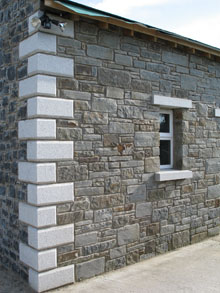The Elsecar engine is a steam-driven Newcomen-type atmospheric pumping engine still in its original engine house at ElsecarFormer mining village in South Yorkshire, six miles north of Rotherham and six south of Barnsley. near Barnsley in South Yorkshire. Designed by John Bargh of Chesterfield, the engine is based on one invented by Thomas Newcomen in 1712. It was erected between 1794 and 1795 at the 4th Earl of Fitzwilliam’s Elsecar New CollieryCollieries in South Yorkshire owned by the Wentworth Fitzwilliams from the late 18th century. to dewater the workings in the Barnsley coal seam, 120 feet (37 m) below the surface;[1] it was restored in 2014.
Engine house
The three-storey engine house is built of masonry with a pitched slate roof, chimneys at either end and stone quoins
Any external angle or corner of a structure. at the corners. It was completed in July 1795 at a cost of £167 19s 3d; a date above the engine house door gives a date of 1787, which predates its completion.
Engine

Wikimedia Commons
The Newcomen-type pumping engine, designed by John Bargh of Chesterfield, was erected at Earl Fitzwilliam’s New Elsecar Colliery at a cost of £1,065 and was operational by September 1795. It dewatered the workings of the 120-foot (37 m) deep Barnsley seam. The engine’s timber rocking beam projected from the top storey of the west side. The beam ends were connected by chains to the pump rods and piston inside the 42-inch (107 cm) diameter cast-iron cylinder; it worked at 6–8 strokes per minute.[2] In 1801, the engine was modified, its cylinder was replaced by another with a 48-inch (122 cm) diameter with a 60-inch (152 cm) stroke. The wooden beam was replaced by a cast-iron beam in 1836. The engine operated until 1923, when electric pumps were installed. It was used for emergencies into the 1930s, and kept on standby in National Coal BoardStatutory corporation created to run the coal mining industry in the United Kingdom under the Coal Industry Nationalisation Act 1946. ownership until 1953, when the base of the cylinder was found to be cracked.[1]
The engine, a scheduled ancient monument, was bought by Barnsley Metropolitan Borough Council in 1988.[3] The engine was restored in 2014.

